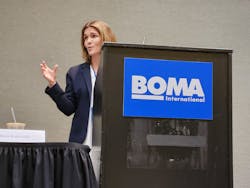5 Smart Strategies for Overcoming the Split Incentive
A Sunday morning session at the 2023 BOMA International Conference & Expo tackled this exact problem. Moderated by Kara Kokernak, senior director for the Urban Land Institute, the panel (which also included Megan Saunders, director of ESG for Kayne Anderson Real Estate, and Ana Duffy, sustainability manager for Hudson Pacific Properties) shared real-life examples of successful strategies and overcoming common net zero obstacles.
This hot topic is becoming more and more relevant in the face of growing pressure to achieve net zero energy and drastically slash carbon emissions. The built environment is responsible for nearly 40% of global carbon emissions and up to 70% of emissions in urban cities, Kokernak shared. About 28% of the 40% is represented by building operations.
In addition, tenant spaces can account for over 50% of a commercial building’s total energy consumption, which means the building owner may have control over less than half of the building’s energy use. Impactful energy reduction must then involve both the owner and the tenants.
“To achieve whole building reductions in carbon emissions, property owners and tenants must work together—sometimes in new and creative ways,” Kokernak said.
5 Ways to Conquer the Split Incentive
Achieving net zero energy in a leased building requires building owners and tenants to work together closely. Net zero energy requires whole-building solutions and buy-in from all tenants, who may have their own individual goals that also need to be met. But working together is easier said than done in some cases.
One of the biggest potential pitfalls facing both owners and tenants looking to achieve net zero energy is the split incentive, Kokernak said. Leased buildings often disincentivize upgrades because the party putting in upgrades and improvements is often not the party reaping the financial rewards. This can negatively affect both owners and tenants, who suffer from the split incentive in similar ways.
“The party that pays up front for the upgrades is not always the one who benefits from energy savings,” Kokernak said. “…There are times when an owner can put in specific energy efficiency improvements, and if your tenant is the one paying the utility and receiving the reduced energy costs, what’s the benefit for you to put that in?”
The presentation dove deep into these five ways to address the split incentive.
1. Green leases. The lease itself can address the split incentive and make sure both the owner and the tenant benefit from upgrades. “One of the most important things we include in our leases is [regarding] capital upgrades to improve building energy efficiency,” noted Duffy. “Any time we’re replacing a boiler or HVAC equipment that improves the energy efficiency in the building, we pass that cost back to the tenant just as we would other expenses. Our utility bills are passed back to tenants, but we’re still incentivized to improve the efficiency of our building.”
2. Data sharing. This may be covered in the lease, or it could be a separate agreement. It should require tenants to report energy performance to the building owner, who can use the data to develop a better idea of the whole building’s performance and plan improvements accordingly. Access to utility bills is a good place to start, Saunders explained. One major stride her firm made this year is asking all tenants to sign a letter of authorization, which allows the utility to pass billing information directly to the property management company.
3. Tenant fit-outs. Bringing in a new tenant? You may not have to gut the whole space. In fact, some tenants might prefer to see how the previous tenant utilized the space so they can picture their own organization in it. Fit-outs are an opportunity to be more efficient with both energy and waste. Saunders’ firm created a guide for tenants on how to integrate sustainability when they’re doing tenant improvements, from low-VOC and recycled products to efficient appliances and lighting.
“When we’re doing tenant improvements, we prioritize energy efficiency,” added Duffy. “We have an energy management and climate change policy that has various clauses written into it.”
4. Behavior change. Education is the cornerstone of any upgrade. Duffy recommends finding the right champion for each tenant who will help that tenant work with you to achieve common goals. “Behavior change has plenty of obstacles,” Duffy said. “For what we can control, tenant engagement is really important.”
5. Renewable energy sources. Rooftop solar isn’t an option for every building, but check in with your utility—you may be pleasantly surprised at your options. “We look to see where we can buy green power directly from the utility,” Saunders said. “We find that Texas and Ohio are key states where we can basically let the tenant know that we can buy power that’s 100% renewable sources at the same cost that we’re delivering brown power. We’re working with tenants to do that where it makes sense from a cost perspective.”
Whole-Building Strategies
Thinking about net zero at the whole-building level requires a truly holistic approach, Kokernak explained. It’s more complicated than just making the building ultra-energy-efficient and including some renewables. The whole-building strategy is a big piece of the puzzle, and collaboration is the way to get there.
“Whole building decarbonization cannot be achieved without owner-tenant collaboration, highlighting the strong business case for sustainable tenant engagement,” Kokernak said. “Measuring whole-building emissions can help property owners and tenants better manage their building performance and meet their respective reporting requirements.”
About the Author
Janelle Penny
Editor-in-Chief at BUILDINGS
Janelle Penny has been with BUILDINGS since 2010. She is a two-time FOLIO: Eddie award winner who aims to deliver practical, actionable content for building owners and facilities professionals.


